

Payment & Security
Your payment information is processed securely. We do not store credit card details nor have access to your credit card information.
We recommend a pulse suppressor (dead-zone) box with Single Mode OTDRs.
Description
Pulse Suppressor Box 9/125 Single Mode SC/UPC
Pulse suppressor boxes, also known as dead-zone boxes or fiber rings, are vital to the success of an OTDR measurement. These boxes are simply long launch cables placed between the OTDR and the near-end patch panel, and serve two key purposes:
Reflections
Reflections caused by connector interfaces "blind" OTDRs for a short period of time. The period of time it takes for an OTDR to recover from this ™blindness™ is commonly referred to as a "dead-zone". During this dead-zone period, OTDRs are unable to distinguish one anomaly (e.g. breaks, shatters, bends, or even another connector) from another. Without a sufficiently long launch cable, the reflection from the near-end patch panel will be undetectable because it is within the dead-zone caused by the OTDR port.
Loss Measurement Through Inter-Connections
To measure the optical loss of any event found on an OTDR trace, there must be sufficient measurable backscatter both before and after the inter-connection. Lack of a dead-zone box means there is no measurable backscatter outside the fiber link under test, preventing the OTDR from measuring the relative loss through both near-end and far-end patch panel connections. As a general rule, pulse suppressor boxes should be longer than the longest pulse width setting of the OTDR used for testing. In most cases, 1-kilometer launch cables are sufficient to account for dead-zones.
Features
Features
- Far-end dead zone box allows the OTDR to measure loss through the far-end patch panel connection
- Near-end dead zone box allows the OTDR to recover from the reflection received from the patch panel and allows the OTDR to measure loss through the patch panel connection
What’s In The Box
What’s In The Box
- Fiber Pulse Suppressor Box
